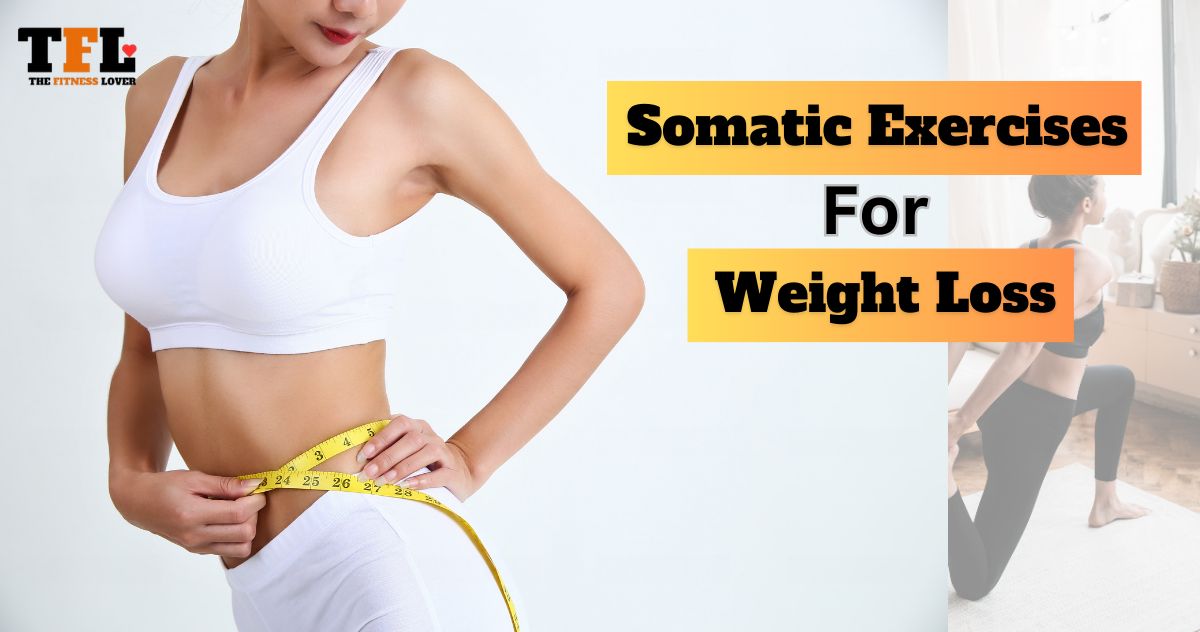Exercise is an important part of a healthy lifestyle and can help with weight loss, but it’s vital to remember that a balanced diet and regular physical activity are the main factors in weight management. Somatic exercises for weight loss can be a helpful complement to your loss weight journey since they emphasize movement awareness and the mind-body connection. But before beginning any new fitness regimen, it’s imperative to speak with a healthcare provider, particularly if you have any underlying medical issues.
Here are some somatic exercises that may support your weight loss efforts:
1. Mindful Walking:
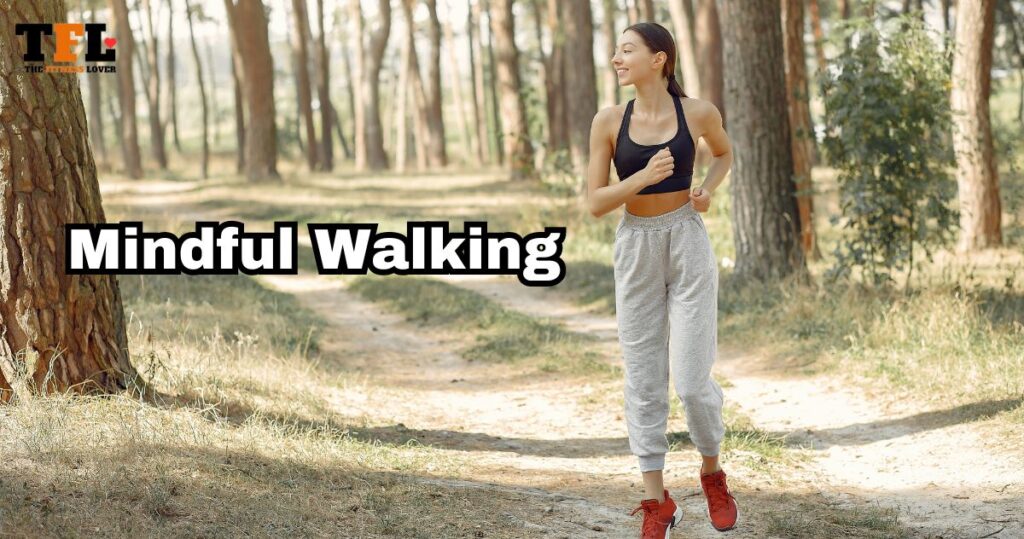
Of course! To cultivate a sense of awareness and presence, mindful walking entails giving the act of walking your whole attention. The following is a guide to walking mindfully:
Find a Quiet Space:
- Choose a quiet and peaceful environment for your mindful walk. It could be a park, garden, or any place where you can walk without distractions.
Stand Tall:
- Begin by standing upright with a relaxed posture. Keep your shoulders back, and let your arms hang naturally by your sides.
Focus on Your Breath:
- Take a few deep breaths to center yourself. Inhale slowly through your nose, allowing your lungs to fill, and exhale gently through your mouth.
Start Walking:
- Begin walking at a natural, unhurried pace. Pay attention to the sensation of your feet lifting off the ground and making contact with it again.
Mindful Steps:
- Be fully present with each step. Notice the subtle movements in your feet and legs. Feel the shifting of your weight from one foot to the other.
Awareness of Surroundings:
- Engage your senses. Notice the sounds around you, the sensation of the air on your skin, and any scents in the environment.
Maintain a Gentle Gaze:
- Keep your gaze soft and directed ahead. Allow your peripheral vision to take in the surroundings without fixating on any particular object.
Return to the Present:
- If your mind starts to wander or gets caught up in thoughts, gently bring your focus back to the act of walking and your surroundings.
Practice Gratitude:
- As you walk, cultivate a sense of gratitude. Appreciate the ability to move, the beauty around you, and the present moment.
Set a Time Frame:
- You can practice mindful walking for a specific duration, whether 10 minutes or longer. Gradually increase the time as you become more comfortable with the practice.
2. Breathing Exercises:
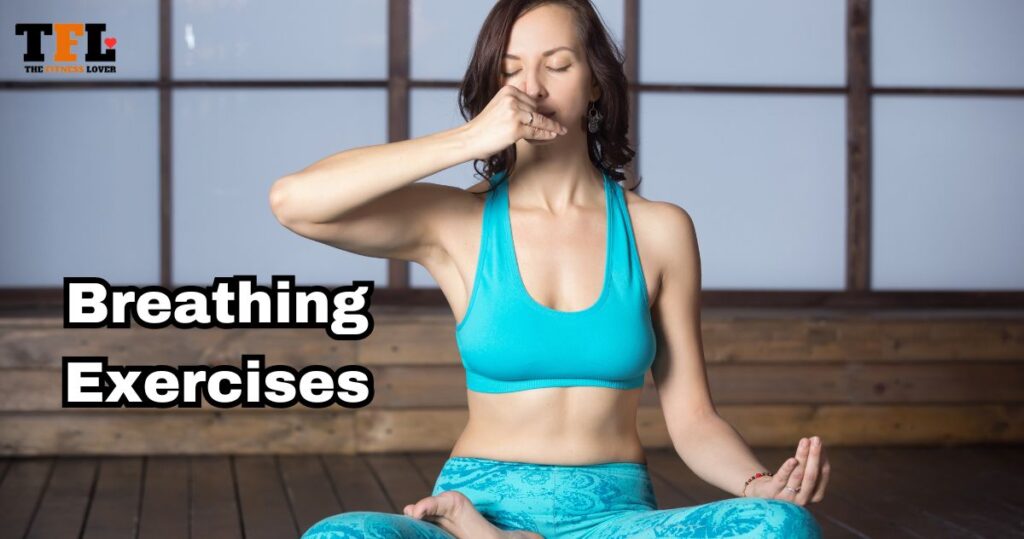
Breathing techniques are useful for fostering mindfulness, lowering tension, and encouraging relaxation. Here’s how to do a quick yet effective breathing exercise:
Diaphragmatic Breathing (Deep Belly Breathing):
Find a Comfortable Position:
- Sit or lie down in a comfortable position. Place one hand on your chest and the other on your abdomen.
Inhale Slowly Through Your Nose:
- Take a slow and deep breath through your nose. Focus on allowing your abdomen to expand as you fill your lungs with air.
Feel the Breath in Your Abdomen:
- As you inhale, ensure that the hand on your abdomen rises more than the hand on your chest. This indicates that you are engaging your diaphragm and breathing deeply.
Exhale Slowly Through Your Mouth:
- Exhale slowly and completely through your mouth or nose. Feel your abdomen gently contract as you release the breath.
Counting Breaths (Optional):
- If you like, you can incorporate a counting rhythm. Inhale for a count of four, hold your breath for a count of four, and exhale for a count of four. Adjust the count based on your comfort.
Focus on the Breath:
- Direct your attention to the sensation of your breath. Notice the coolness of the inhale and the warmth of the exhale.
Eliminate Tension:
- As you breathe out, consciously release any tension in your body. Let go of stress with each exhale.
Repeat the Process:
- Continue this deep breathing pattern for several minutes, allowing yourself to relax and be present with each breath.
Practice Regularly:
- Incorporate diaphragmatic breathing into your daily routine. It can be done whenever you feel stressed, or anxious, or simply as a regular practice for overall well-being.
3. Body Scan Meditation:
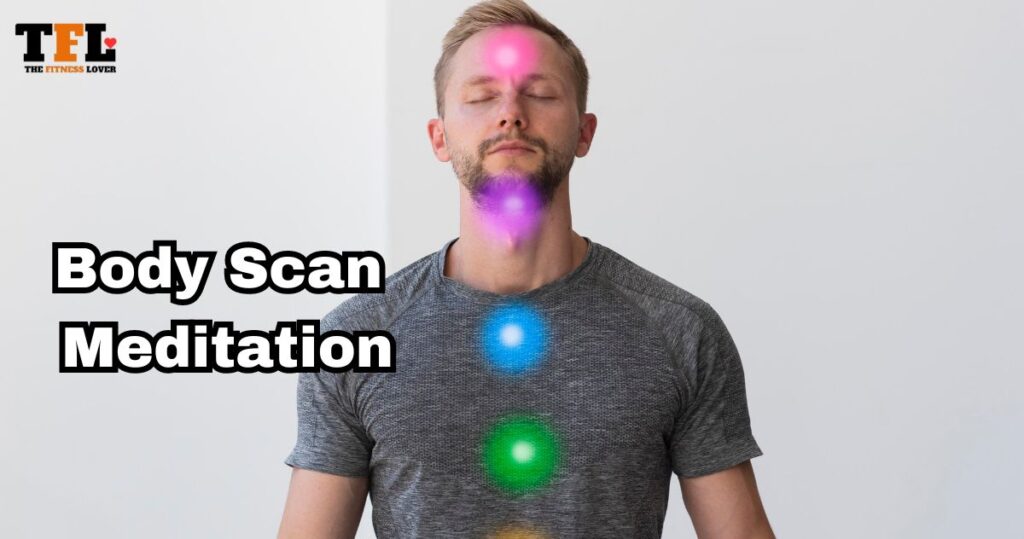
A mindfulness technique called body scan meditation is focusing your attention on various body areas, methodically examining them, and letting go of any tension. The following is a tutorial for body scan meditation:
Find a Comfortable Position:
- Sit or lie down in a comfortable position. If lying down, keep your legs uncrossed and your arms by your sides. If sitting, ensure that your back is straight and your hands rest comfortably on your lap or knees.
Close Your Eyes (Optional):
- If you feel comfortable, close your eyes to minimize external distractions. Alternatively, you can keep them gently open with a soft gaze.
Focus on Your Breath:
- Begin by taking a few slow, deep breaths. Allow your breath to be natural and relaxed.
Bring Attention to Your Toes:
- Direct your focus to your toes. Notice any sensations, warmth, or tension in this area. As you breathe in and out, let go of any tension.
Move to Your Feet and Ankles:
- Gradually shift your attention to your feet and ankles. Scan for sensations, and with each breath, release any tightness or discomfort.
Progress Upward:
- Continue moving upward, scanning each part of your body. Pay attention to your lower legs, knees, thighs, hips, and so on. Release tension as you go.
Observe Your Torso:
- Bring your awareness to your abdomen, lower back, upper back, and chest. Notice the rhythm of your breath and any sensations in these areas.
Scan Your Arms:
- Extend your focus to your shoulders, upper arms, elbows, forearms, wrists, and hands. Relax and let go of any tension in these regions.
Explore Your Neck and Head:
- Move your attention to your neck, jaw, face, and the top of your head. Be aware of any sensations and consciously release any tightness.
Whole Body Awareness:
- Finally, expand your awareness to your entire body. Feel the interconnectedness of each part and embrace a sense of relaxation and presence.
Conclude Mindfully:
- When you’re ready to conclude the practice, take a few deep breaths and gradually bring your attention back to the present moment.
4. Gentle Yoga:
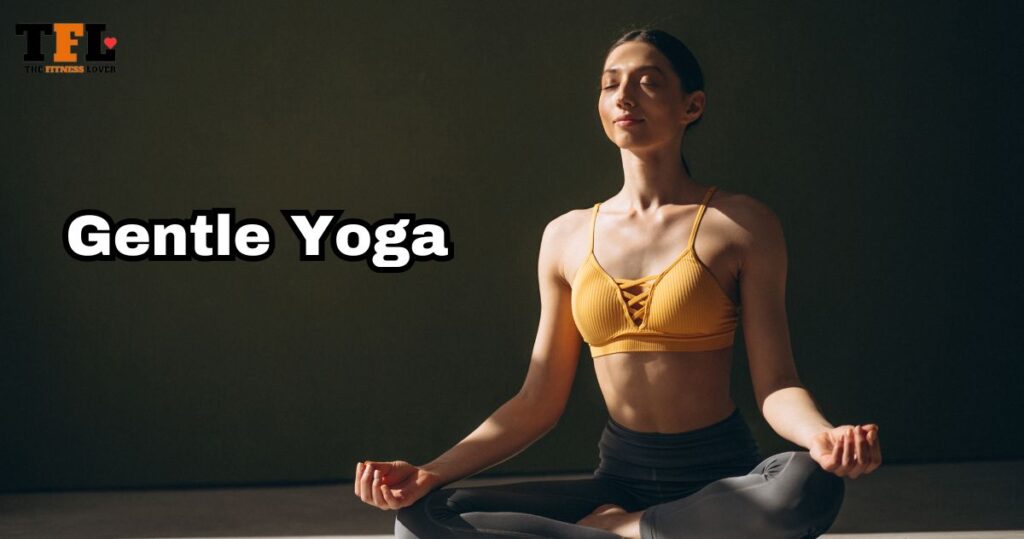
Gentle yoga is a style of yoga that emphasizes breath awareness and relaxation via slow, deliberate practices. Here’s a basic, mild yoga routine guide:
Mountain Pose (Tadasana):
1. Stand with your feet hip-width apart.
2. Ground your feet, lengthen your spine, and relax your shoulders.
3. Inhale deeply as you reach your arms overhead, palms facing each other.
4. Hold the pose for a few breaths, feeling the stretch in your body.
Child’s Pose (Balasana):
1. Start on your hands and knees in a tabletop position.
2. Sit back on your heels, extending your arms forward on the mat.
3. Rest your forehead on the ground and breathe deeply, feeling the stretch in your back.
Cat-Cow Stretch (Marjaryasana-Bitilasana):
1. Return to a tabletop position with your wrists under your shoulders and knees under your hips.
2. Inhale as you arch your back, dropping your belly and lifting your head (Cow).
3. Exhale as you round your spine, tucking your chin to your chest (Cat).
4. Repeat this flow for a few breaths, moving between Cow and Cat.
Downward-Facing Dog (Adho Mukha Svanasana):
1. From tabletop position, tuck your toes and lift your hips toward the ceiling.
2. Straighten your legs, keeping a slight bend in the knees.
3. Press your palms into the mat and lengthen your spine.
4. Hold the pose, feeling the stretch in your hamstrings and shoulders.
Warrior I (Virabhadrasana I):
1. Step one foot forward into a lunge, keeping the back foot turned out slightly.
2. Inhale as you lift your arms overhead, palms facing each other.
3. Square your hips to the front and bend the front knee.
4. Hold the pose, feeling the strength in your legs and openness in your chest.
Seated Forward Bend (Paschimottanasana):
1. Sit with your legs extended in front of you.
2. Inhale as you lengthen your spine, and exhale as you hinge at your hips to reach forward.
3. Hold onto your shins, ankles, or feet, keeping a straight back.
4. Breathe deeply, feeling the stretch along your spine and hamstrings.
Corpse Pose (Savasana):
1. Lie on your back with your legs extended and arms by your sides.
2. Close your eyes and focus on your breath, allowing your body to relax completely.
3. Stay in this pose for a few minutes, absorbing the benefits of your practice.
5. Tai Chi or Qigong:
Both Qigong and Tai Chi are traditional Chinese exercises that emphasize deep breathing, fluid, slow motions, and the development of Qi (or life energy) within the body. This is a quick introduction to Qigong and Tai Chi:
Tai Chi:
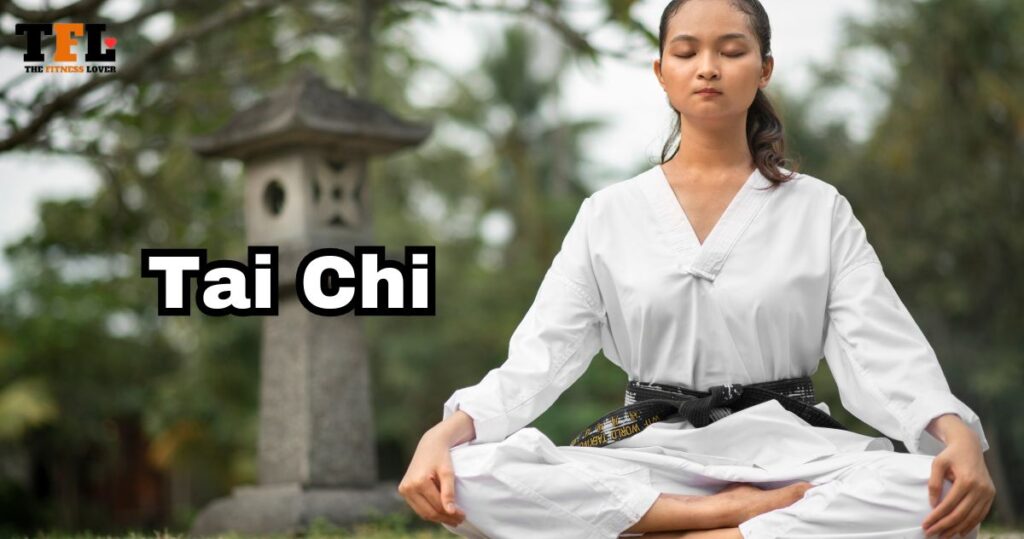
Starting Position (Wuji Stance):
- Stand with your feet shoulder-width apart, knees slightly bent.
- Selax your shoulders, keep your spine straight, and place your hands by your sides.
Commencement:
- Inhale as you raise your arms in front of you, palms facing down.
- Exhale as you lower your arms to the starting position.
Ward Off (Peng):
- Step forward with your left foot, keeping the weight centered.
- Raise your arms in a circular motion, palms facing outward.
Grasp the Sparrow’s Tail:
- Flow into a sequence of movements involving ward off, rollback, press, and push.
- These movements are executed in a continuous, slow, and controlled manner.
Single Whip:
- Shift your weight, turn your body, and extend one arm in a whipping motion.
- The other hand rests near your hip.
Cloud Hands:
- Perform a flowing, circular motion with your arms as you shift your weight from side to side.
Snake Creeps Down:
- Bend forward and lower your body, mimicking the movement of a snake.
Golden Rooster Stands on One Leg:
- Shift your weight to one leg, raising the other leg in a controlled manner.
Closing Form:
- Bring your movements to a close, returning to the Wuji Stance.
Qigong:
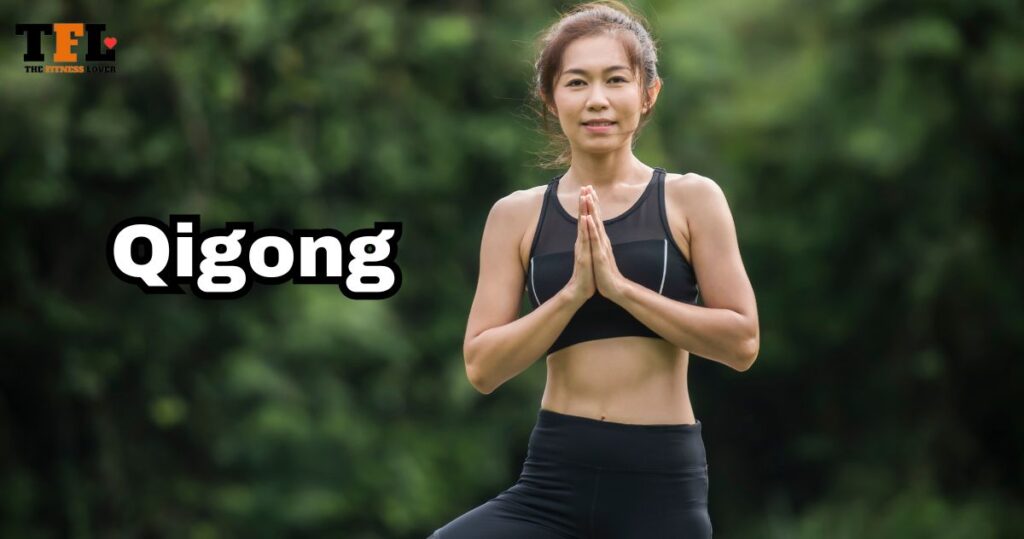
Wuji Stance:
- Similar to Tai Chi, start in a relaxed standing position with feet shoulder-width apart.
Balancing the Qi:
- Inhale deeply, raising your arms to the sides and then overhead.
- Exhale slowly as you bring your hands down in front of your body.
Three-Circle Qigong:
- Extend your arms in front of you, forming three circles with your hands.
- Rotate your hands in one direction, then the other, coordinating with your breath.
Gathering Energy (Holding the Ball):
- Hold an imaginary ball in front of your chest, feeling the energy between your hands.
Five-Animal Play:
- Emulate the movements of five animals (tiger, deer, bear, monkey, and crane) in a slow and controlled manner.
Eight Pieces of Brocade (Baduanjin):
- Perform a series of eight exercises that involve stretching and moving the body to promote energy flow.
Closing Meditation:
- Stand quietly, bringing your hands to your lower abdomen, and focus on your breath for a few moments.
6. Pilates:
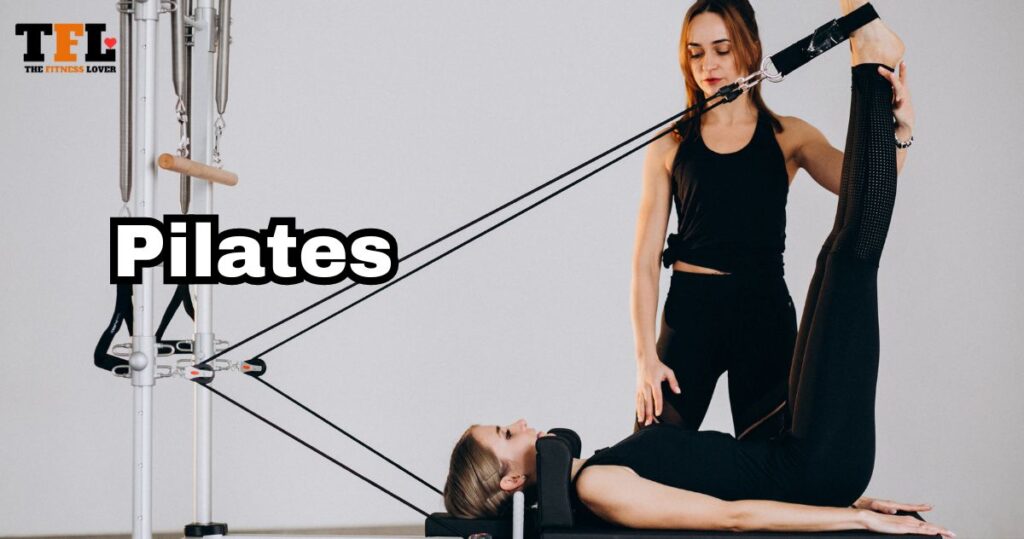
Pilates is a low-impact training technique that emphasizes developing flexibility, strengthening the core, and increasing total body control. Here’s a short tutorial on some essential Pilates poses:
The Hundred:
- Lie on your back with your legs in a tabletop position (knees bent at a 90-degree angle).
- Lift your head, neck, and shoulders off the mat, reaching your arms straight forward.
- Pump your arms up and down while breathing in for five counts and out for five counts.
Roll-Up:
- Start lying on your back with your arms extended overhead.
- Inhale, then exhale as you peels your spine off the mat, reaching forward to touch your toes.
- Inhale at the top, and then exhale as you roll back down.
Single Leg Stretch:
- Lie on your back with your head and shoulders lifted.
- Bring one knee toward your chest while extending the other leg straight out.
- Switch legs in a scissor-like motion while maintaining a lifted upper body.
Plank:
- Start in a push-up position with your hands under your shoulders.
- Engage your core and maintain a straight line from head to heels.
- Hold the position, keeping your abdominals pulled in.
Pilates Push-Up:
- Begin in a plank position with straight arms.
- Lower your body down toward the mat, keeping your elbows close to your sides.
- Push back up to the starting position.
Bridge:
- Lie on your back with your knees bent and feet hip-width apart.
- Lift your hips toward the ceiling, creating a straight line from your shoulders to your knees.
- Engage your gluts and core, and hold the position.
Swan Dive:
- Lie on your stomach with your arms reaching overhead.
- Lift your chest and arms off the mat, keeping your legs grounded.
- Lower back down with control.
Side Plank:
- Lie on your side with your elbow directly beneath your shoulder.
- Lift your hips to create a straight line from head to heels.
- Hold the position, engaging your core.
Teaser:
- Sit on the mat with your legs extended and arms reaching forward.
- Inhale, then exhale as you lifts your legs and torso simultaneously, balancing on your sit bones.
- Inhale at the top, and then exhale as you lower back down.
Seated Spine Stretch:
- Sit with your legs extended, feet flexed.
- Inhale as you sit tall, then exhale as you hinge forward from your hips, reaching toward your toes.
7. Somatic Movement Exercises:
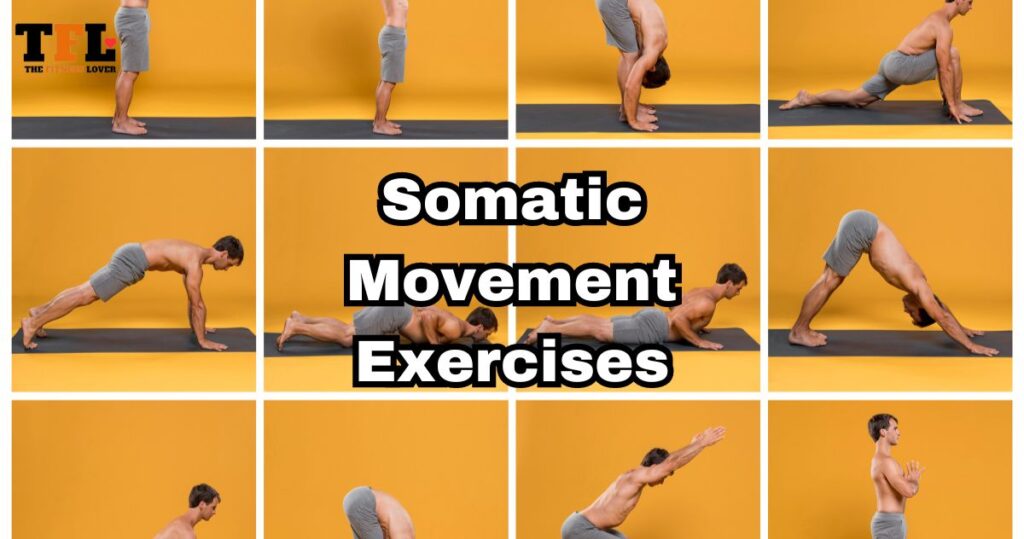
Exercises using somatic movement aim to enhance general movement patterns, alleviate muscle tension, and raise body awareness. Here is a list of some fundamental exercises using somatic movement:
Pandiculation:
- Begin by standing or sitting comfortably.
- Contract a specific muscle or group of muscles in a gentle and intentional manner.
- Slowly release the contraction, allowing the muscles to lengthen and relax fully.
- Repeat this process for different muscle groups, promoting awareness of muscular sensations.
Neck and Shoulder Release:
- Sit or stand comfortably.
- Inhale and gently tilt your head to one side, bringing your ear toward your shoulder.
- Exhale and allow the opposite shoulder to drop, creating a stretch along the side of your neck.
- Inhale as you return to the center, then repeat on the other side.
Sensory Motor Amnesia (SMA) Release for the Back:
- Lie on your back with knees bent and feet flat on the floor.
- Bring awareness to your lower back and gently arch and flatten your spine, exploring the range of motion.
- Move slowly, paying attention to the sensations and releasing any tension.
Breathing Exploration:
- Lie on your back with your hands on your abdomen.
- Focus on your breath, feeling the rise and fall of your abdomen with each inhale and exhale.
- Experiment with different breath patterns, such as diaphragmatic breathing or alternate nostril breathing, to promote relaxation.
Hip Circles:
- Stand with feet hip-width apart.
- Circle your hips in a slow and controlled motion, exploring the range of motion.
- Reverse the direction of the circles after a few repetitions.
Spinal Undulation:
- Stand or sit comfortably.
- Start at the base of your spine and initiate a wave-like motion, moving through each segment of your spine.
- Allow the movement to flow smoothly from the tailbone to the neck, promoting spinal flexibility.
Full Body Integration:
- Lie on your back with arms extended overhead.
- Inhale as you lengthens your body, reaching fingertips and toes away from each other.
- Exhale as you release and soften into the floor, allowing your body to settle.
Body Rolling:
- Sit or lie down on a soft surface, like a mat or blanket.
- Slowly roll different parts of your body, exploring areas that feel tense or restricted.
- Use the natural movement of your body to release tension and increase awareness.
Gentle Walking Meditation:
- Walk slowly and mindfully, paying attention to the sensation of each step.
- Feel the connection of your feet with the ground, and allow your body to move with ease.
Joint Mobility:
- Move each joint in your body through its full range of motion, starting from your toes and working your way up to your neck.
- Emphasize smooth and controlled movements, exploring the articulation of each joint.
Keep in mind that the secret to any fitness program is consistency. For weight loss to be effective and long-lasting, a balanced, nutritious diet must be combined with somatic exercise. To design a customized strategy that fits your health goals and considerations, it’s also a good idea to speak with a fitness expert or healthcare specialist.
